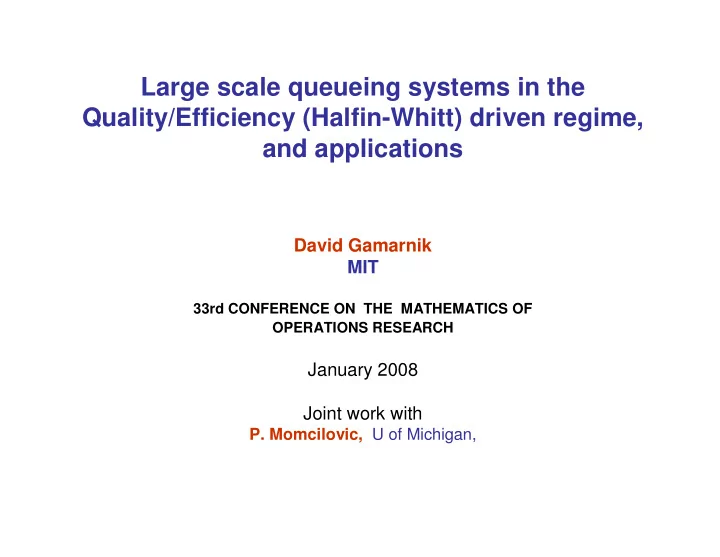

Large scale queueing systems in the Quality/Efficiency (Halfin-Whitt) driven regime, and applications David Gamarnik MIT 33rd CONFERENCE ON THE MATHEMATICS OF OPERATIONS RESEARCH January 2008 Joint work with P. Momcilovic, U of Michigan,
Talk Outline • GI/GI/N queueing model • Applications to call/contact centers • Challenge: non-Markovian systems • Results I : Markov chain characterization of the queue length process • Result II : Interchange of Heavy Traffic-Steady State limits. Tight decay rate. • Discussion of methods: Lyapunov functions • Further challenges
Model: G/G/N queueing system
Model: G/G/N queueing system Kiefer & Wolfowitz [56] – Steady state regime exists (stability) iff … but no explicit formulas for except Erlang M/M/N (Erlang-C) formulas
Efficiency Halfin-Whitt Theory (summary) In M/M/N queueing system in steady-state if Quality then Also
Furthermore: • Extends to non-Poisson arrival processes: G/M/N will return to this • Extends to phase-type service times: Puhalskii & Reiman [2000] • Diffusion approximations:
Motivation: Call Centers Tradeoff between utilization (cost of staffing N) and performance
Motivation: Call Centers Surveys: M. Armony: http://www.stern.nyu.edu/om/faculty/armony/research/CallCenterSurvey.pdf A. Mandelbaum: http://iew3.technion.ac.il/serveng/References/references.html W. Whitt: http://www.ieor.columbia.edu/~ww2040/CallCenterF04/call.html Papers on queueing models of call centers by Atar, Armony, Baron, Bassamboo, Brown, Dai, Green, Gans, Garnett, Gurvich, Harrison, Jelenkovic, Jennings, Halfin, Kolesar, Kumar, Maglaras, Mandelbaum, Massey, Momcilovic, Randhawa, Reed, Reiman, Sakov, Shen, Shimkin, Tezcan, Whitt, Zeevi, Zeltin, Zhao, Zohar
Motivation: Call Centers Brown, Gans, Mandelbaum, Sakov, Shen, Zeltyn, Zhao [2002] Statistical Analysis of a Telephone Call Center: A Queueing-Science Perspective. One of the conclusions: service times have log-normal distribution.
General service time distributions • Deterministic service times: Jelenkovic, Mandelbaum & Momcilovic [2004] • G/G/N virtual waiting times process limits, discrete service times: Mandelbaum & Momcilovic [2005] • G/G/N process limits: Reed [2006]
Principal questions for this work: • What about G/G/N in steady state ? • Does hold in general? Assumption: service times have a discrete probability distribution. Summary of results: • Markov chain characterization of the limiting process • Tight decay rate for the limiting queue length in steady-state
Consider the following Markov chain on where
- centered work in progress Discrete service times Theorem I. [Transient] Suppose Halfin-Whitt regime Initialization Then
Theorem II. [Steady-state] • has a unique stationary distribution • Exponential tightness • Interchange of limits Confirmed
Interchange of limits Kiefer & Wolfowitz
Theorem II. [Steady-state] Moreover (exact decay rate) Same decay rate as the conventional heavy-traffic model of G/G/N!
Illustration • Service time • Arrival rate
Illustration
Illustration
Illustration
Illustration Scaling N does not reveal anything. Look at Gaussian scaling:
Illustration • Case I Then Subtract the means • Case II similar …
Illustration • Case II similar … Putting things together, the Markov chain dynamics is obtained Dynamical system is hard to analyze even without stochastic fluctuations.
Steady-State Proposition . The process satisfies - stationary Gaussian process When is “large”, the drift is
Steady-State Theorem . is a (geometric) Lyapunov function.
Lyapunov function argument is used to show that • has a stationary distribution • • for some
Summary, Challenges and ongoing work: • G/G/N in Halfin-Whitt regime with discrete service time distribution. Process level and steady-state results. • Tight decay rate for the queue length in steady-state. • Challenge: non-discrete service times. • In progress: relaxation in M/M/N in Halfin-Whitt (joint work with D. Goldberg)
Recommend
More recommend